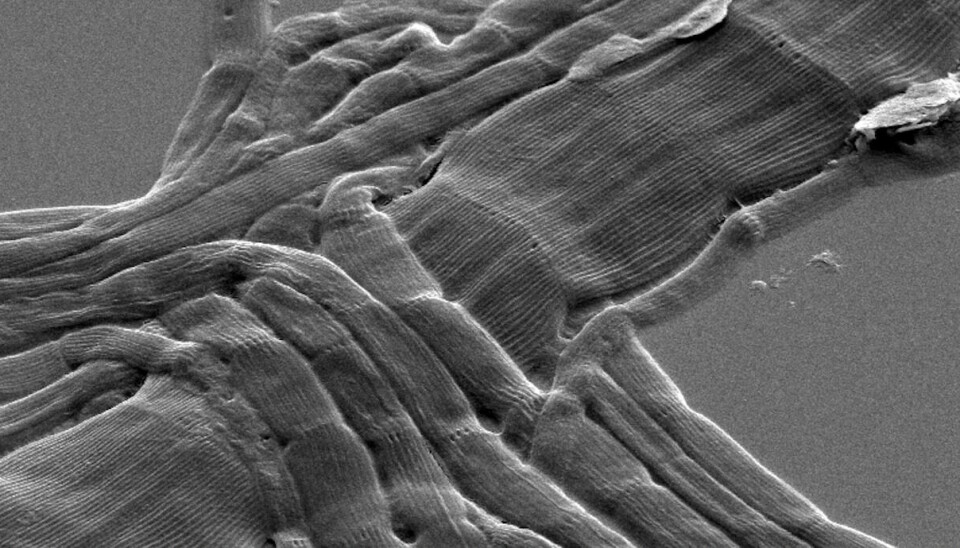Researchers' Zone:

Two myths about bacteria you should put away
Bacterial cells are not necessarily as small as you might expect. We are now slightly closer to understanding how big bacterial cells can exist.
When most of us first encounter microorganisms in biology class, we learn that bacteria are the simplest, possibly most boring, of all forms of life.
We learn that bacteria are small, single-celled organisms without the complex structures that make plants and animals so distinctive.
Decades of microbiology research, including some of it carried out by myself and colleagues at Aarhus University, has shown that these two ‘defining characteristics’ of bacteria (small and single-celled) are far from universal.
As different as guts and lungs
Let’s start with the claim that bacteria are single-celled (unicellular) organisms. 11 years ago, a new multicellular bacterium was discovered by my colleagues at Aarhus University. These bacteria were dubbed cable bacteria due to their ability to conduct electrons across several centimetres in the mud at the bottom of lakes, rivers, and the ocean – just like a cable conducts electricity.
Cable bacteria are filamentous bacteria up to several centimetres in length. That’s tens of thousands of times longer than the smallest bacterial cells.
Each cell in the filament is only about 3 micrometres in length (1 micrometre = 1/1,000,000 meter), and each individual cable bacterium consists of a chain of thousands of individual cells.
But having more than one cell does not make a bacterium multicellular – there’s not that much difference between a mass of unconnected identical cells and a chain of identical cells. True multicellularity is when different cells carry out different functions – and that’s exactly what cable bacteria do.
The cells in the deep sediment ‘eat’ (oxidise) hydrogen sulphide, while cells in the sediment surface ‘breathe’ (respire oxygen).
In this way, cable bacteria cells in the same filament can be just as different from one another as our guts and lungs.
No, all bacteria are not single-celled organisms
Cable bacteria were by no means the first multicellular bacteria to be discovered. In the 19th century the first observations of filamentous cyanobacteria (blue-green algae) showed that some cells in the filament had a rounder shape with thicker cell walls.
It was later discovered that these cells, called “heterocysts”, fix nitrogen from the atmosphere and supply the remaining cells with amino acids.
Nitrogen fixation is inhibited by oxygen, and since the cyanobacteria produce oxygen through photosynthesis, nitrogen fixation needs to occur in special cells where oxygen production is turned off.
In this way, we observe a clear division of labour between different cell types in various bacteria.
Filamentous cyanobacteria, cable bacteria, and other multicellular bacteria make it impossible to use unicellularity as a defining characteristic for bacteria.
Candidatus Electrothrix gigas in motion. Sample taken from Hou Beach south of Aarhus. (Video: Lars Peter Nielsen)
Closer to solving the mystery of big bacteria
The other defining characteristic of bacteria that ought to be put down is that their cells are small – usually we say that bacteria have a diameter of about a micrometre.
This is much smaller than, say, human cells, which are between 5 and 20 micrometres across, or certain single-celled algae, which can grow up to several millimetres in size.
It was always thought that cells from animals, plants, and other organisms with cell nuclei (eukaryotes) may grow much bigger due to their ‘cytoskeletons’; the cell’s internal structure and ‘highway system’.
The cytoskeleton consists of intracellular filaments made of various proteins – such as actin and tubulin – that support the cell’s structure and transport chemicals around the cell across distances that would be insurmountable by passive spreading alone.
Bacteria lack this eukaryotic cytoskeleton, but still in some cases manage to grow much bigger than the usual ~1 micrometre – the record holder is the genus Thiomargarita with cells up to 750 micrometres in diameter and a length of over 9000 micrometres.
How these cells can survive without a cytoskeleton has been a mystery – but my colleagues and I at Aarhus University and the University of Antwerp in Belgium have just moved a little closer to explaining this mystery. To get there we took a shortcut via our favourite research topic: Cable bacteria.
Newly discovered protein may be the answer
Most cable bacteria are, like most other bacteria, about 1 micrometre in diameter. But every now and again we would observe a cable bacterium that was many times thicker than the others – up to 8 micrometres.
By sequencing the genomes from these thick cable bacteria, we discovered that they are actually an entirely different species, which we named Candidatus Electrothrix gigas, which means ‘giant electric hair’.
The giant cable bacteria carry a gene that the smaller cable bacteria don’t – a gene encoding a protein similar to actin, the same actin that we know from the cytoskeletons of plants and animals.
There are other actin-like proteins in cable bacteria, but this actin-relative was entirely new.
The most exciting finding came when we looked for this new type of actin in genomes from other bacteria: We found the gene almost exclusively in genomes from large bacteria, including Thiomargarita.
Our hypothesis is that this newly discovered protein forms some kind of cytoskeleton that supports the growth of large cells just like in eukaryotes (animal and plant cells). We have therefore named this protein ‘big bacteria protein’.
We hope that we will soon be able to follow up on this discovery with more research that will be able to decipher the precise role of big bacteria protein in cable bacteria and other large bacteria.
In the meantime, we hope that our research can help to dismantle the myth that bacteria are small, unicellular, and (maybe) boring.
Bacteria can have big cells and build large multicellular structures, where different cells perform different functions. And that’s not boring, that’s just plain exciting.





